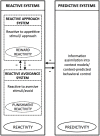Perceptual Sensitivity and Response to Strong Stimuli Are Related
- PMID: 29018377
- PMCID: PMC5615480
- DOI: 10.3389/fpsyg.2017.01642
Perceptual Sensitivity and Response to Strong Stimuli Are Related
Abstract
To shed new light on the long-standing debate about the (in)dependence of sensitivity to weak stimuli and overreactivity to strong stimuli, we examined the relation between these tendencies within the neurobehavioral framework of the Predictive and Reactive Control Systems (PARCS) theory (Tops et al., 2010, 2014). Whereas previous studies only considered overreactivity in terms of the individual tendency to experience unpleasant affect (punishment reactivity) resulting from strong sensory stimulation, we also took the individual tendency to experience pleasant affect (reward reactivity) resulting from strong sensory stimulation into account. According to PARCS theory, these temperamental tendencies overlap in terms of high reactivity toward stimulation, but oppose each other in terms of the response orientation (approach or avoid). PARCS theory predicts that both types of reactivity to strong stimuli relate to sensitivity to weak stimuli, but that these relationships are suppressed due to the opposing relationship between reward and punishment reactivity. We measured punishment and reward reactivity to strong stimuli and sensitivity to weak stimuli using scales from the Adult Temperament Questionnaire (Evans and Rothbart, 2007). Sensitivity was also measured more objectively using the masked auditory threshold. We found that sensitivity to weak stimuli (both self-reported and objectively assessed) was positively associated with self-reported punishment and reward reactivity to strong stimuli, but only when these reactivity measures were controlled for each other, implicating a mutual suppression effect. These results are in line with PARCS theory and suggest that sensitivity to weak stimuli and overreactivity are dependent, but this dependency is likely to be obscured if punishment and reward reactivity are not both taken into account.
Keywords: masked auditory threshold; overreactivity; perception; punishment reactivity; reward reactivity; sensitivity; suppression effect; temperament.
Figures



Similar articles
-
Food Approach and Food Avoidance in Young Children: Relation with Reward Sensitivity and Punishment Sensitivity.Front Psychol. 2016 Jun 24;7:928. doi: 10.3389/fpsyg.2016.00928. eCollection 2016. Front Psychol. 2016. PMID: 27445898 Free PMC article.
-
Temperamental factors in severe weight cycling. A cross-sectional study.Appetite. 2015 Aug;91:336-42. doi: 10.1016/j.appet.2015.04.064. Epub 2015 Apr 27. Appetite. 2015. PMID: 25931432
-
Affective modulation of the startle reflex and the Reinforcement Sensitivity Theory of personality: The role of sensitivity to reward.Physiol Behav. 2015 Jan;138:332-9. doi: 10.1016/j.physbeh.2014.09.009. Epub 2014 Oct 20. Physiol Behav. 2015. PMID: 25447471
-
[Personality factors in depressive disorders: contribution of the psychobiologic model developed by Cloninger].Encephale. 2002 Jul-Aug;28(4):363-73. Encephale. 2002. PMID: 12232546 Review. French.
-
Sensitivity to reward and punishment in eating disorders.Psychiatry Res. 2010 May 15;177(1-2):1-11. doi: 10.1016/j.psychres.2009.06.010. Epub 2010 Apr 9. Psychiatry Res. 2010. PMID: 20381877 Review.
Cited by
-
The role of temperament in alcohol use among college students.Addict Behav Rep. 2021 Jun 27;14:100366. doi: 10.1016/j.abrep.2021.100366. eCollection 2021 Dec. Addict Behav Rep. 2021. PMID: 34938827 Free PMC article.
-
Cross-cultural adaptation and validation of the Spanish sensory processing sensitivity questionnaire (S-SPSQ).Front Psychol. 2024 May 2;15:1279889. doi: 10.3389/fpsyg.2024.1279889. eCollection 2024. Front Psychol. 2024. PMID: 38756486 Free PMC article.
-
Intergenerational Transmission of Depressive Symptoms in Chinese Families: The Role of Mothers versus Fathers and Adolescent Perceptual Sensitivity.Psychol Res Behav Manag. 2025 Jun 23;18:1481-1493. doi: 10.2147/PRBM.S519632. eCollection 2025. Psychol Res Behav Manag. 2025. PMID: 40585296 Free PMC article.
-
Do we enjoy what we sense and perceive? A dissociation between aesthetic appreciation and basic perception of environmental objects or events.Cogn Affect Behav Neurosci. 2022 Oct;22(5):904-951. doi: 10.3758/s13415-022-01004-0. Epub 2022 May 19. Cogn Affect Behav Neurosci. 2022. PMID: 35589909 Free PMC article. Review.
References
-
- Bachman J. G., O’Malley P. M. (1984). Yea-saying, nay-saying, and going to extremes: black- white differences in response styles. Public Opin. Q. 48 491–509. 10.1086/268845 - DOI
-
- Baumgartner H., Steenkamp J.-B. E. M. (2001). Response styles in marketing research: a cross-national investigation. J. Mark. Res. 38 143–156. 10.1509/jmkr.38.2.143.18840 - DOI
LinkOut - more resources
Full Text Sources
Other Literature Sources

